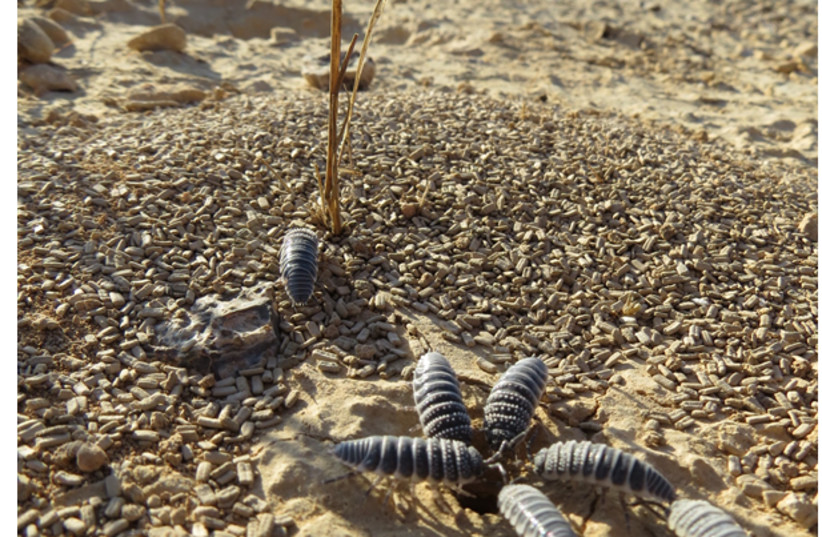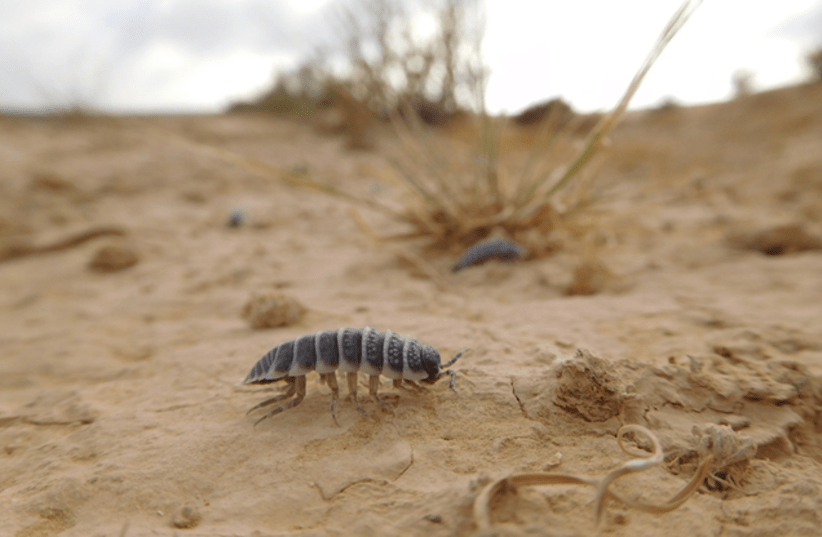Isopods (Hemilepistus reaumuri) are strange little creatures that look like lice or cockroaches – and aren’t bugs at all but crustaceans. Common names for them include woodlice, roly-poly, pill bug, sea roach, and pill bug, but there are over 10,000 identified species of isopods around the world, with half of them living on land, 4,500 species found in sea beds and other marine environments, and the rest in fresh water.
They got the name isopod from “iso,” which means “equal,” and “pod” that stands for “foot.” What they have in common are segmented external skeletons, seven pairs of jointed limbs on the chest, two pairs of antennae, and five pairs of branching appendages on the abdomen that are used to breathe.
Now, a new study has been conducted under the guidance of Prof. Dror Hawlena from the Hebrew University and led by Dr. Moshe Zaguri (then a doctoral student and now at the Volcani Institute in Rishon Lezion,) in collaboration with Prof. David Raubenheimer from the University of Sidney.
The research sheds light on the intricate nutritional and functional dynamics shaping the dietary choices of desert isopods. It has just been published in the journal Ecology Letters entitled “Dust you shall eat: complex considerations underlying a simple diet.” The study presents the multifaceted considerations that influence food selection by these fascinating creatures.
Contrary to expectations, wild isopods showed a preference for macronutrient-poor biological soil crust (BSC) over plant litter, consuming three times more of the former.
These revolutionary findings may shed new light on how different animals and humans choose their diet by considering both the foods nutrients and the existence of digestive assisting agents.
Dietary choices in desert isopods

Foods are complex mixtures of chemical compounds provided in various levels of digestibility that humans and animals ingest for nutritional support. Often, animals need to ingest several food types to fulfill their multidimensional nutritional needs and may suffer harm to their health by not eating the needed nutrients in specific quantities and ratio.
Understanding what factors influence dietary choices is, thus, a very important but extremely challenging question to study. The authors’ focused on the simple-but-mysterious diet of the desert isopods that eat dry leaves and large quantity of nutritionally poor biological soil crust (the upper lair of desert soils that harbor many microorganisms.)
They fed isopods with natural and artificial foods and found that when allowing a choice, isopods can strictly regulate their food consumption to meet a very specific ratio of proteins, sugars and calcium. Isopods received most of their proteins and sugars from dry leaves and eat soil crust to meet their very high calcium needs.
The exoskeleton of isopods is made of calcium carbonates that they must consume in large quantities to grow; when they could supplement leaf litter with artificial sources of calcium, they successfully met their exact calcium needs but suffered reduced growth.
The scientists used gamma-radiation to kill the microorganisms in the soil crust while maintaining its nutritional value and measured the isopods’ food assimilation efficiency and growth rate in comparison to isopods that ate untreated crust. They found that the crustaceans eat the crust to incorporate live microorganisms to their digestive system. Those microbes assisted to improve digestion of the fibrous plant litter.
The team concluded that isopods eat foods that allow them to meet their nutritional needs by providing the nutrients but also by helping them to digest. Humans do not eat soil crust but may think about the general insights of this interesting study during their next visit to the local grocery shop.
The research revealed that desert isopods rigorously regulate their intake of macronutrients and calcium, with phosphorus intake remaining unaffected. Moreover, the team observed that despite equivalent calcium ingestion, isopods thrived better when consuming BSC compared to artificial foods.
Notably, isopods consuming gamma-radiation-sterilized BSC exhibited increased consumption but slower growth rates compared to those consuming live BSC, suggesting the crucial role of ingested microorganisms in facilitating litter digestion.
Zaguri commented that “our findings underscore the complexity of dietary decision-making among desert isopods and highlight the importance of considering multifaceted factors in understanding trophic [food chain] interactions.”
